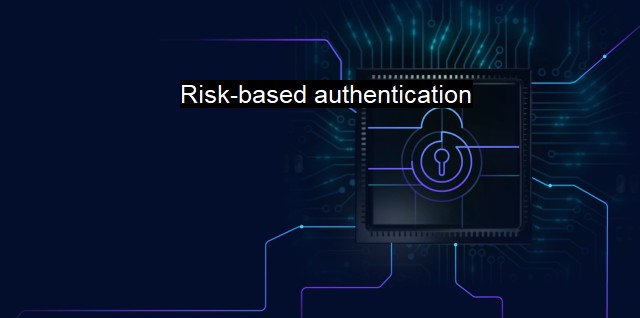What is Risk-based authentication?
Enhancing Cybersecurity: How Risk-Based Authentication Defines the Future of Identity and Access Management
Risk-Based Authentication (RBA) is an advanced cybersecurity approach used to ensure secure access to data, applications, networks, and resources. As a method centered on multi-level/layered authentication, RBA offers a dynamic interaction with the user, varying the authentication method based on the risk level of the potential transaction or data access. RBA is a process that strengthens login protocols by subjecting transactions and device access to a myriad of security checks based on identified risks.The principal tenet of Risk-Based Authentication is operating on the assumption that not all access requests, transactions, or users pose the same level of risk. Adopting a one-size-fits-all authentication method may inadvertently open an avenue for attackers to exploit a weakness or loophole, hence the need for RBA.
An effective RBA system continuously evaluates the risk associated with a user or transaction based on detected user behavior and profile, quantifying the risk to guide the authentication processes. If the risk score is low, the system may simply ask for the regular username and password. On the other hand, if the risk score is high, this would trigger additional verification mechanisms such as multi-factor authentication (MFA).
One of the aspects that are assessed in risk-based authentication is user behavior. This could include IP address, geolocation, time of connection, or type of requested operation. Existing perceptions or previously documented profiles can help guide this evaluation. If new behavior deviates from the norm, a higher risk is assigned and additional authentication steps are warranted.
Another aspect is the sensitivity level of the requested resource or information. Suppose someone tries accessing highly sensitive data, such as credit card information or user passwords. In that case, regardless of prior account behavior, this will probably necessitate further verification measures.
Risk-based authentication can also prove beneficial in meeting compliance needs and building user trust. It simplifies the user experience while handling high-risk situations with the necessary vigor.
RBA also has potential challenges. If user behavior is consistently considered risky due to changes in activities or work conditions, the constant high-level authentication requirements could decrease productivity because of high false positives. If the simultaneous exercise of implementation and user training is not accomplished strategically, the sudden shift to high-level authentication could lead to user deterrence and frustration.
The relationship between RBA and antivirus software is symbiotic. Antivirus software detects malicious activities and threats, whereas RBA attempts to ensure only authorized entities access sensitive data, reducing the likelihood of threats being executed. Antivirus application aids in dynamic identification and mitigation of any threat, while RBA amplifies the dynamic defense against possible intrusions triggered by seemingly authorized access.
RBA plays a unique role in line with data privacy regulations. An effective RBA system focuses on methods that enhance data protection, secure end-user credentials, and drastically reduce the occurrence of security breaches while refining regulations compliance concerning data privacy.
Risk-Based Authentication is a tailor-made approach to securing data and access, judging each situation individually and providing just enough sophistication to reduce the likelihood of unauthorized access. It is a middle-ground way of authentication, taking note of vulnerability and providing layers of defense against both external and internal threats. By being highly adaptive and holistic with regards to different access factors, the RBA serves a critical role still demanding further proactive, intelligent, and interactive technologies to enhance its efficiency and effectiveness.

Risk-based authentication FAQs
What is risk-based authentication?
Risk-based authentication is a cybersecurity technique that uses various criteria to determine the level of security risk involved in a particular login attempt or transaction. Based on this risk assessment, appropriate security measures are applied to ensure that only legitimate users gain access and malicious ones are blocked.How does risk-based authentication work?
Risk-based authentication works by analyzing several factors surrounding a login or transaction, such as the device being used, the IP address, the location, and the user behavior. These factors are analyzed and given a risk score based on the probability of the login attempt being fraudulent. Based on this score, the system decides whether to grant access, deny access or require additional forms of authentication.What are the benefits of risk-based authentication?
The benefits of risk-based authentication are numerous. Firstly, it helps reduce the number of false positives and false negatives thereby increasing the accuracy of cybersecurity measures. Secondly, it helps reduce the risk of identity theft, unauthorized access, and fraud which can be costly for businesses. Lastly, it improves user experience by making the login process more seamless and user-friendly.What are the challenges of implementing risk-based authentication?
The challenges of implementing risk-based authentication include the need for a reliable source of data, the cost of implementation, and the potential for false positives which can lead to legitimate users being denied access. Careful analysis of the factors used for risk assessment and regular monitoring and tuning of the system can help mitigate these challenges and ensure an effective risk-based authentication system| | A | | | B | | | C | | | D | | | E | | | F | | | G | | | H | | | I | | | J | | | K | | | L | | | M | |
| | N | | | O | | | P | | | Q | | | R | | | S | | | T | | | U | | | V | | | W | | | X | | | Y | | | Z | |
| | 1 | | | 2 | | | 3 | | | 4 | | | 7 | | | 8 | | |||||||